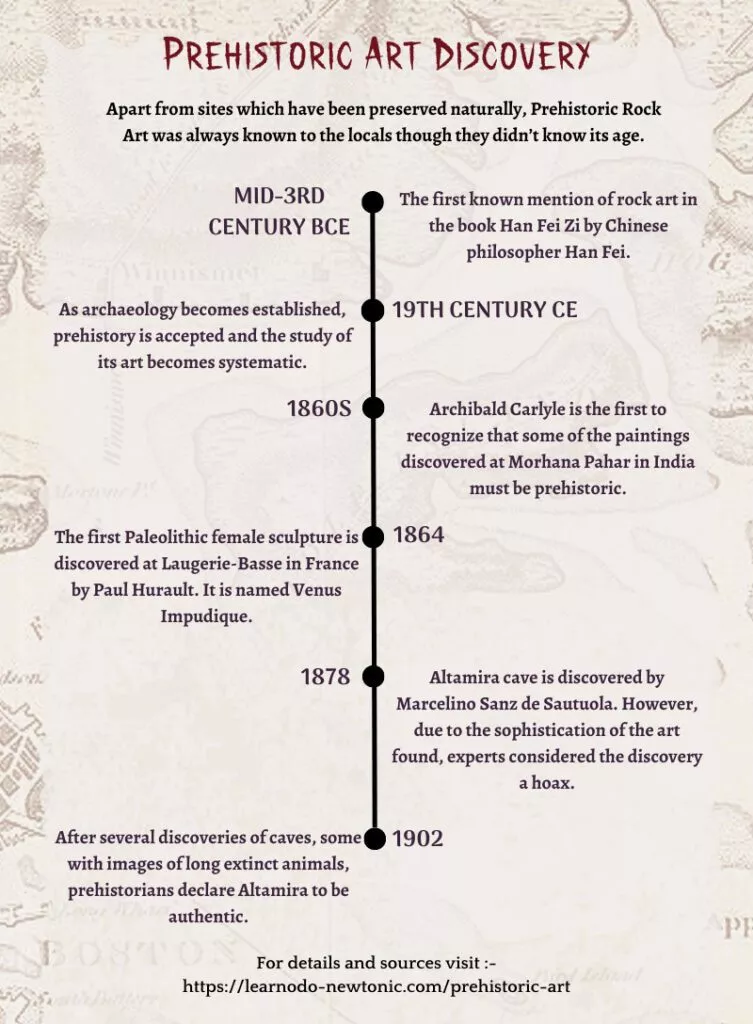Mesolithic Art is art created in the Middle Stone Age, which lasted from approximately 10,000 BCE to 8,000 BCE. Prehistoric Art is usually divided into two types: rock art and portable artworks like sculptures. Mesolithic rock art is dominated by depictions of humans, unlike the preceding Paleolithic era where cave paintings mostly depicted animals. There have been only a few discoveries of sculptures which have been dated to the Mesolithic period. These include the famous Shigir Idol. Here is an overview of Mesolithic Art including its characteristics, discovery, purpose and more.
S1 – Mesolithic Era
The Paleolithic period lasted from the first known use of stone tools by hominins around 3.3 million years ago till the end of the last ice age around 11,700 years ago (c. 10,000 BCE). The Neolithic era began when farming communities began to be established. The period between these two eras is known as the Mesolithic era. The start and end dates of the Mesolithic era varies by geographical regions. It is dated approximately between 10,000 BCE to 8,000 BCE.
The word Mesolithic is a combination of two Greek words mesos (middle) and lithos (stone). The Middle Stone Age or the Mesolithic era saw the shift from simple and large chipped stone tools of the Paleolithic period to smaller chipped stone tools known as microliths. The other major change was that humans shifted from group hunting of large animals to a more hunter-gatherer way of life.

S2 – Mesolithic Art Characteristics
Like the Paleolithic era, rock paintings dominate the surviving examples of Mesolithic art. They are similar in nature to the Paleolithic paintings. However, due to warmer climates, art moved from caves to vertical cliffs or walls of natural rock. It is thought that the locations of the paintings were not random and were selected due to some magical, sacred or religious significance.
The biggest difference between Paleolithic and Mesolithic art is that of subject matter. While depictions of animals dominated Paleolithic cave art, Mesolithic rock paintings have more human depictions. The depicted humans are highly stylized and not realistic. They look more like pictographs than pictures.

Some of the finest examples of Mesolithic rock art may be found in India at several sites including Bhimbetka, Adamgarh and Pachmarhi. At Pachmarhi, paintings may be found which depict scenes from everyday life and hunting as well as that of warfare. At Adamgarh, human figures may be seen hunting, dancing, running, playing games, etc. There are also numerous animal depictions in various poses. Similar Mesolithic art is present at the site of Bhimbetka.
S3 – Prehistoric Art Discovery


S4 – Some Important Mesolithic Art Discoveries
| Discovery | Type | Discoverer | Year | Nation |
|---|---|---|---|---|
| Shigir Idol | Sculpture | Alexey Stenbok-Fermor | 1890 | Russia |
| Cueva de las Manos | Rock Art | Alberto Maria de Agostini | 1941 | Argentina |
| Bhimbetka | Rock Art | Dr. Vishnu Wakankar | 1957 | India |
S5 – Prehistoric Art Purpose


Sources:-
S1:-
Buis, Alena. “Art and Visual Culture: Prehistory to Renaissance”. “Mesolithic Art”.
S2:-
Esaak, Shelley. (Sep 01, 2018). “Art of the Mesolithic Age”. ThoughtCo. Dotdash Meredith.
Unit 3 “Mesolithic Art”. eGyanKosh.

